

Double.Parse Method (String, NumberStyles) (System) The s parameter can contain the current culture's NumberFormatInfo.PositiveInfinitySymbol, NumberFormatInfo.NegativeInfinitySymbol, or NumberFormatInfo.NaNSymbol.
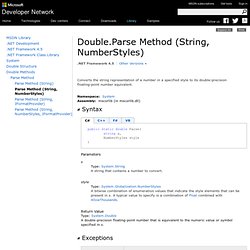
Depending on the value of style, it can also take the form: [ws][$][sign][integral-digits[,]]integral-digits[. [fractional-digits]][E[sign]exponential-digits][ws] Elements in square brackets ([ and ]) are optional. The following table describes each element. string value; value = Double.MinValue.ToString(); try { Console.WriteLine(Double.Parse(value)); } catch (OverflowException) { Console.WriteLine("{0} is outside the range of the Double type. SharePoint Interview Questions for Developers. Interview Questions for Developers - A four-part series.

Part 1 Part 2 Part 3 Part 4 Part 5 {new} Q. What Do you know about SharePoint Object Model? Formatting Types. [This topic is pre-release documentation and is subject to change in future releases.
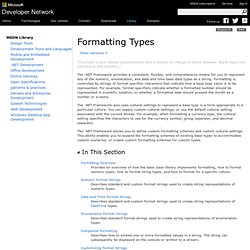
Blank topics are included as placeholders.] The .NET Framework provides a consistent, flexible, and comprehensive means for you to represent any of the numeric, enumeration, and date and time base data types as a string. Formatting is controlled by strings of format specifier characters that indicate how a base type value is to be represented. For example, format specifiers indicate whether a formatted number should be represented in scientific notation, or whether a formatted date should present the month as a number or a name. The .NET Framework also uses cultural settings to represent a base type in a form appropriate to a particular culture. The .NET Framework allows you to define custom formatting schemes and custom cultural settings. How Do I Get Paths and URL fragments from the HttpRequest object? - Cambia Research. Summary If you have done much ASP.NET programming you have probably spent a lot of time mapping urls to physical disk locations and vice versa.
This need arises whenever you store files on the server or do some kind of URL parsing and re-routing of incoming requests. This article will examine the properties of the Request object that will provide path and url information related to the application and the current request. First, here are a couple of tables of useful properties on the Request object and an example of the text they return for a given input URL. For some reason unclear to me, the Url.Fragment property is usually empty instead of showing "#fragment". Input: Input: The following is the C# method I used to process the URLs above and generate the output tables. Learn CSS Positioning in Ten Steps: position static relative absolute float. 1. position:static The default positioning for all elements is position:static, which means the element is not positioned and occurs where it normally would in the document.
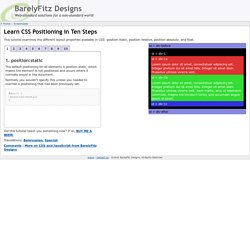
Normally you wouldn't specify this unless you needed to override a positioning that had been previously set. 2. position:relative If you specify position:relative, then you can use top or bottom, and left or right to move the element relative to where it would normally occur in the document. Let's move div-1 down 20 pixels, and to the left 40 pixels: SharePoint Site Logo URL Limitations – Site Settings Page vs Web Part Pages « Nik Patel's SharePoint World. Code Tricks- Tips and tricks on PHP, CGI, JavaScript, ASP, XML, CSS, and more! Anyone who's had to display data in multiple pages in ASP know how much trouble it can be.
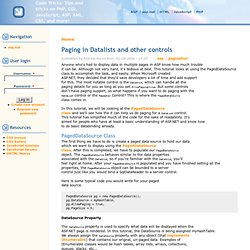
Although not very hard, it's tedious at best. Making Sense of ASP.NET Paths. ASP.Net includes quite a plethora of properties to retrieve path information about the current request, control and application.
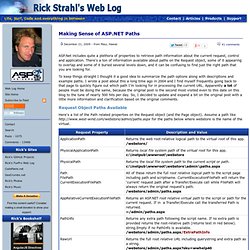
There's a ton of information available about paths on the Request object, some of it appearing to overlap and some of it buried several levels down, and it can be confusing to find just the right path that you are looking for. URL Encoding. RFC 1738: Uniform Resource Locators (URL) specification.

?: Operator (C# Reference) The security validation for this page is invalid. Click Back in your Web browser, refresh the page, and try your operation again. « Welcome to ShanthaKumar’s Blog. Posted by: Shantham | March 9, 2009 The security validation for this page is invalid.

Click Back in your Web browser, refresh the page, and try your operation again. The above error will be thrown at the time of updating Library or Lists items due to authentication problem, or We didn’t have the rights to update the items. Disposing Objects. You can identify the potential presence of incorrectly disposed objects by asking the following questions: Does your application pool recycle frequently, especially under heavy loads (assuming that the application pool is set to recycle when a memory threshold is reached)?

The memory threshold should be 800 megabytes (MB) to 1.5 gigabytes (GB), assuming at least 2 GB of RAM. Setting the recycle of the application pool to occur closer to 1 GB gives the best results, but experiment to determine what settings work best for your environment. If the recycle setting is too low, your system experiences performance issues because of frequent application pool recycles. If the setting is too high, your system experiences performance problems because of page swapping, memory fragmentation, and other issues.